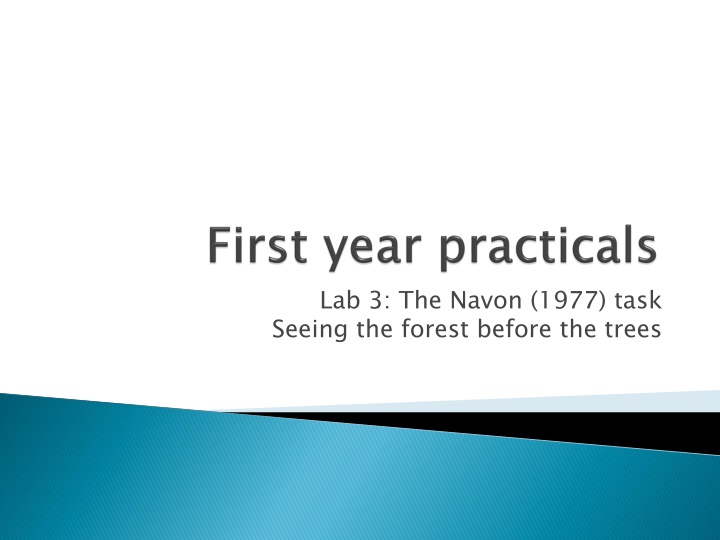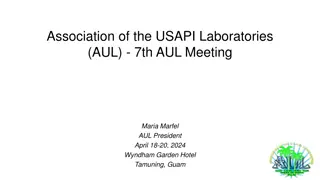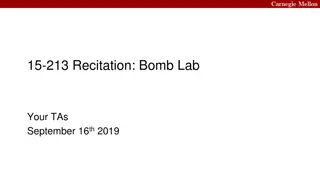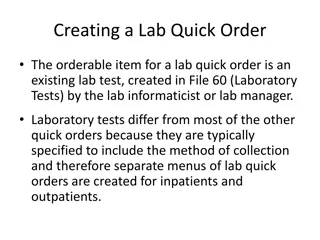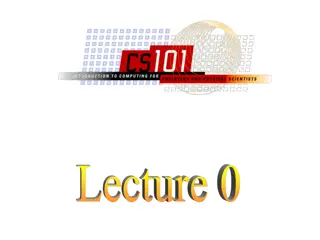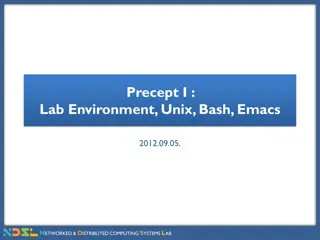Essential Components of a Lab Report for Academic Success
Understanding the importance of a well-structured lab report, this content outlines key sections like abstract, introduction, methodology, results, and discussion for effective communication of experimental findings.
Download Presentation

Please find below an Image/Link to download the presentation.
The content on the website is provided AS IS for your information and personal use only. It may not be sold, licensed, or shared on other websites without obtaining consent from the author.If you encounter any issues during the download, it is possible that the publisher has removed the file from their server.
You are allowed to download the files provided on this website for personal or commercial use, subject to the condition that they are used lawfully. All files are the property of their respective owners.
The content on the website is provided AS IS for your information and personal use only. It may not be sold, licensed, or shared on other websites without obtaining consent from the author.
E N D
Presentation Transcript
Lab 3: The Navon (1977) task Seeing the forest before the trees
In this class you will learn about; Writing a report (mimicking a journal article) Navon s study (1977) of global versus local processing in perception
One aspect of the lab course is to develop skills in experimental design, data analysis, interpretation etc. However we need to be able to express these ideas/skills within a written form The lab report! By writing reports in your 1styear you will develop a better writing style and through feedback, will learn how to structure a good report. This will be invaluable for your 2nd& 3rdyears.
The aim of a lab report is to indicate to the reader the following: Why did you bother? How did you do it? You should ask yourself Could someone replicate my experiment using the information I have provided them with? What did you find? What were the results of your investigation? So what? How do your results relate to your hypothesis & what theoretical contribution do they make?
Sometimes reports (certainly some published papers!) can be lengthy. To reduce the time looking for specific information we rely on a standard structure for a report. Not every published paper contains all of the following sections/sub-sections, but you should include them if they are relevant.
Title Abstract Introduction Method Design Participants Apparatus & Materials (optional) Procedure Scoring (optional) Results Discussion References Appendix (optional) You will see these sections referred to on the feedback coversheet which markers use to help you to improve your reports!
This is the first thing someone reads and so should summarise the content of the report using no more than 20 words Gives some indication of the overall theme of the work that is to be reported Catchy titles should generally be avoided, as should titles using superfluous words An Empirical Investigation into Obsessive Compulsive Disorder in Children with High Socioeconomic Status Parents. Obsessive Compulsive Disorder in Children with High Socioeconomic Status Parents. NB: Capitalize major words & centre the title at the top of the page
Dont be too vague The Beer-Goggles Effect. Don t be too specific An Investigation Into the Effects of Drinking 6 Pints of Guinness in a Nightclub in Brighton at 11:30, While Listening to Drum and Bass Played at 100 db Through a Good Sound System, on 12 Men s and 15 Women s Ability to Accurately Judge the Attractiveness of Members of the Opposite Sex.
About right The Beer-Goggles Effect : The Effects of Alcohol on Attractiveness Ratings of the Opposite Gender. Sometimes it is useful to refer to the things you are manipulating (the IV) & what you are measuring (DV) within the title The example above does just this IV = Alcohol (as levels are manipulated in this study) DV = Ratings of attractiveness
The abstract is a short prcis (about 100-150 words) of the study that is about to be presented below it It is often what a reader will use to determine whether to bother to read the rest of the study E.g. A literature search online will often provide the abstract of the paper
It should ideally contain a brief statement of the problem being investigated & motivation for the study the participants investigated the experimental method of study the principal findings/results obtained the main conclusions drawn Try not to finish with empty statements such as The findings were discussed . It is normally easier to write the abstract last, once you know what key points of the study should be summarised.
Ugly (1993) has shown that the propensity to misclassify members of the op posite sex as attractive is increased in nightclub settings. This study was designed to ascertain whether this effect is due to the dim lighting emplo yed in these venues, or the consumption of alcohol in this setting. Ratings of th e attractiveness of a set of stooge participants were taken in both a well -lit and dimly- lit nightclub by both sober and drunk participants. A 2 way ANOVA reveal ed a significant effect of alcohol consumption, but not of the lighting use d. The results suggest that, contrary to Ugly s hypothesis, dim lighting does not contribute to the inflated attractiveness of opposite-- gender mates; instead these ratings are influenced solely by alcohol intake. You can see that this abstract is short, but summarises what was done and why, and finishes with what was found from the results and how this fits with previous studies/theories.
An introduction is a little like writing an essay It should try to answer the following questions: Broadly introduce the area you are investigating. You may need some definitions What has been done in this area of psychology before? In other words, review the current literature (theories/findings) about the topic you are investigating. Are their any inconsistencies/problems in the research so far? What was the point/purpose of your study?
State your hypothesis explicitly (but informally) towards the end of your introduction. This often means making reference to the IV(s) & DV (but informally) E.g. This study looks at whether the amount of alcohol drunk and the gender of the consumer has an effect on the attractiveness of the mate selected. What do you expect or predict may happen? If you have an expectation then say so. E.g. Based on previous research discussed earlier, it is predicted that attractiveness ratings will increase as alcohol amount increases, but only for males. Attractiveness ratings made by female participants are not expected to be influenced by alcohol consumption.
Possible reasons/rationale for a study To support/test a specific theory/idea To replicate/confirm an existing finding A replication with a different sample To extend the findings of previous research Often a replication with a change in method State what differences are between your study and an existing study To distinguish between different theories or resolve an anomaly (e.g. Contradictory results from previous studies) To plug as gap in existing knowledge The introduction doesn t need a separate heading TIP: Do not state the null hypothesis in the introduction. You can assume that the reader knows what a null hypothesis is. TIP: Do not state the null hypothesis in the introduction. You can assume that the reader knows what a null hypothesis is.
Someone should be able to repeat your experiment by reading this section! Include enough information for replication of the study, but avoid superfluous information E.g. A pencil and paper were used to record the participant s gender . The Method always has clearly labelled sub-sections, but these do vary according to the type of experiment and the Journal type E.g. You may not always need an apparatus section (unless, for example, you used a MRI scanner and wanted to report the details about it)
Design Participants Apparatus and/or Materials (optional) Procedure Scoring (optional) Sometimes the order of these sub-sections will be different if you pick up an academic paper. Try to stick with the order above.
Here you should formally describe the type of design being used (using psychological design language) This is more often the case for an experimental design where IVs are manipulated and DVs measured. Not all designs (e.g. correlational) have IVs! Directly mention and define all IV(s)/DV(s). Remember to report units of measurement for DVs! Conditions of the design should be mentioned and how they were manipulated E.g. Design type might be a between-subjects design
How many participants were tested under each condition? Any design controls should be mentioned here. E.g. If the design counterbalanced for the ordering of two conditions, then say so. How did you assign participants to conditions (or orders of conditions)?
Example: A repeated measures design was used. There were two independent variables: the lighting used in the nightclub (bright or dim) and the level of alcohol consumed (none or 6 pints). There were two dependent variables that were analysed separately: the participant s ratings of physical attractiveness (the COAR scale) and their ratings of the attractiveness of personality (the CRAPS scale). Participants took part in all four conditions of the experiment.
So who were tested in your experiment? What age and gender were they? How did you select them? A random sample? A snowball sample? A convenience sample? How many of them were there? Were there specific characteristics (selection criteria) of the people you tested that should be mentioned? E.g. All participants were right handed and bilingual. Only mention such things if if they are important to your study
Example: Fifty participants completed all conditions of this study: 25 were male and 25 female. Ages ranged from 18 to 39 years (M = 24.26, SD = 3.52 years). Participants were all undergraduate students at the University of Sussex who took part in return for free admission to the nightclub. All participants were naive to the purpose of the experiment.
This section describes the apparatus and materials used in testing the participants Apparatus includes specialist equipment e.g. An Apple Mackintosh computer running E-Prime. Clear sentences should be used to describe apparatus/materials and not bulleted lists! Sometimes a Stimuli section is used to describe the stimulus materials that participants responded to E.g. Stimuli were four geometric shapes, each containing the letter A-D. Shapes were approximately 2cm wide by 2cm high and were presented in red. Sometimes you might find it easier to give some visual examples of stimuli if relevant within a figure, which you can make reference to in your write-up.
Title (in italics) A B D C Figure 1: Examples of the four geometric shape stimuli used in the procedure (not to scale). Caption Reports can contain figures and/or tables and reference to any figure/table should be made in the main text of your report. A figure can be a graph, charts, drawings, a photograph, a diagram, etc. and these elements are always referred to as a figure figure should have a title/caption below Just to be awkward, tables have the title and caption above figure and numbered consecutively. The below it (as in the example at the top!) above the table!!
Figures/Tables often help explain things in fewer words The reader should not have to refer to the text to understand your tables and figures: there should be explanatory figure/table captions Figures and tables are labelled independently E.g. Figure 1 then later Table 1 (not Figure 1 then later Table 2!) Axes on graphs should be clearly labelled Units of measurement should be clear Don t refer to graphs , diagrams , pictures , photographs etc. in your main report text; use the terms Figure and/or Table
This section should state how the design was implemented with the pre-mentioned participants, using the pre-mentioned design and apparatus/stimuli. So when participants took part, what happened to them, and in what order, from the moment they began? Mention important timings (especially important in many cognitive tasks). Need enough detail to be able to replicate the procedure. Only include relevant detail! TOO DETAILED: E.g. Participants arrived 10 minutes before the start of the experiment. They were permitted, but not required, to sit. The wind was coming from the West
Very long instructions that were given to participants can be put into an appendix (but must be referred to e.g. For a full transcript of the instructions, see appendix 1. ) Shorter instructions can be included in the main procedure section. Any emphasis within instructions about how to respond should be made clear E.g. Participants were asked to respond as quickly as possible but were also reminded to be as accurate as they could be.
This section provides the reader with a clear, concise summary of the data you collected and the results of any statistical tests Normally two parts to the results (not sub-sections though!) 1. Means, standard deviations etc. for each group/condition 2. to examine the data t-tests, ANOVA results, correlations etc. E.g. An independent samples t-test was performed to examine any differences between the male and female groups. Males performed significantly faster than females (t (29) = 3.65, p < .05) Note that italics are used for a statistic and for probability Describe/Present the descriptive statistics Follow with inferential statistical tests you have performed
When referring to descriptive/summary statistics try to be consistent with APA style M represents a mean. Mdn represents a median SD represents the standard deviation. SE represents standard error. Remember to use UNITS e.g. Males were faster than females on the image rotation task (Males: M = 20.1, SD = 3.6 msecs; Females: M = 30.5, SD = 7.3 msecs) A graphical representation of summary statistics is best when there are a few means to compare If there are lots of means/summary statistics then you may want to present them in table form
Always report the following information when reporting a statistic analysis the value of the test statistic degrees of freedom (or number of subjects) one- or two- tailed test the observed p-value whether the test result was significant Exact probability: E.g. The mean reaction time for the younger children was significantly slower than for the older children (t (14) = 12.56; p = .03, two-tailed test) Or: The mean reaction time for the younger children was significantly slower than for the older children (t (14) = 12.56; p <.05, two-tailed test) APA suggests rounding to 2 decimal places and many authors do not use a leading zero for probabilities e.g. p=.54 rather than p=0.542
Remember: Descriptive statistics should be reported in sentence form or in a table (not a list) Statistical tests should be reported in the standard format for that test. You might want to check your C81MST lectures for tips on this too! Explain what these tests mean in relation to your experiment and the predictions
Dont cut and paste tables from SPSS into your results section Don t include statistical calculations (by hand or computer) Don t include raw data in the results section (You can put it in the appendix if necessary) Don t try to complicate your results- this section is often best to be left as clear and straightforward as possible Don t interpret your results at this stage save that for the Discussion. But you should state your results in an understandable form. e.g.: Males were faster than females is a statement about your results Males were faster than females which supports the findings of Calder (1989), but is in opposition to Broad s (1990) theory which posited that the female brain was more developed for knitting skills is a discussion & doesn't belong in the results section.
This section is where you can interpret your findings and relate them to previous research/predictions. Often you will make reference to material you raised in your introduction. General structure: State what the results are by providing a pr cis (in words) of the results. Account for the findings. Explore the implications of the findings.
What were the key findings? Were there any significant differences between conditions? If so, then what direction were those differences in? Do they support the hypothesis/hypotheses?
Discuss what these results mean You will either have 1. Rejected the null hypothesis (in favour of the experimental hypothesis) , or 2. Failed to reject the null hypothesis If 1. then are you sure that the effect was due to your manipulation of the IV or could confounding variables explain the result? If 2. then try to convince the reader that there is no relationship between the IV and DV. Either way, try your best to explain the findings
Are there any implications based on your results? Are there any weaknesses of your study that may suggest factors to be improved? Don t tear apart your study! Constructive criticism is OK This may pave the way to discuss any future research Finally, conclude with a short paragraph summarising the main findings / implications
Follow the APA style of referencing See Referencing/APA one-off lecture & the online Guidelines on how to write a report References cited in the report (in text citations) must also appear in your end reference list (and vice-versa) Don t directly cite articles/books that you haven t actually read: Learn to use Secondary source citations E.g. Jones (1999) suggested that cats were more neurotic than dogs (as cited in Eysenck & Keane, 2006) , then just list the source (E & K) in the end reference list. Guidelines on how to write a report web-page
Example 1: Evidence suggests that old people cause more road traffic accidents than new drivers (Killers, 2005). Example 2: A study by Killers (2005) highlighted that road traffic accidents were more likely to be caused by older drivers than drivers who had only recently passed their test.
When assessing the practical reports the markers consider five broad issues: Content and evaluate the conducted research?) Global Structure specified in the School s document on writing reports?) Local Structure relevant information?) Reasoning research conducted and a suitable conclusion drawn?) Evaluation of evidence appropriately?) Content (does the report suitably motivate, justify, analyse Global Structure (does the report adhere to the format Local Structure (does each section of the report contain the Reasoning (is there a convincing line of argument for the Evaluation of evidence (is the relevant literature evaluated You may also want to take a look at the Practicals Feedback Sheet (available from the School Office)
A good book Andy Field & Graham Hole (2003). How to design and report experiments. Sage: London. Chapter 9, p. 287 onwards Write in the past-tense throughout (apart from any predictions made in the intro can be phrased in the future tense) Avoid personal grammar ( I , We etc.) Thanks to Andy Field from whom much of this material has been stolen!
In a series of experiments David Navon (1977) explored the relationship between global and local perception. Theoretical claim: Perceptual processes are temporally organised so that they proceed from global structuring toward more and more fine grained analysis . This is known as Global Precedence Global Precedence
Required participants to respond to either the local or global level of the stimuli. Location of presentation varied to prevent participants from using strategies. 2 conditions Independent variable: Dependent variable 2 conditions: Local-directed & Global-directed Independent variable: Consistency Dependent variable: Reaction time in milliseconds
Table 1. The means and standard deviations for the Global and Local directed conditions for both congruent and incongruent trials Global Directed Mean (ms) 462 477 Global Directed Local Directed Mean (ms) 573 664 Local Directed Std Dev (ms) 39 40 Std Dev (ms) 43 52 Consistent Conflicting In the local-directed condition the mean reaction time was significantly greater in the conflicting than in the consistent condition (p<0.01)
The results of this experiment suggests that the global pattern is responded to faster than the local components. Moreover, whereas people can voluntarily attend to the global pattern without being affected by the local features, they are not able to process the local features without being aware of the whole (pg. 371, Cognitive Psychology, 9, 1977) Navon argues that the finding that attention cannot be efficiently diverted from the whole may be interpreted as support to the notion that global processing is a necessary stage of perception prior to more fine-grained analysis.
Aims to replicate Navons findings for the Local Directed condition ONLY. Same stimuli as Navon used Varies the location that stimuli are presented on screen (top left, top right, bottom left, bottom right) making the task harder I.V Congruence of small/large letters D.V. Reaction time (seconds)
